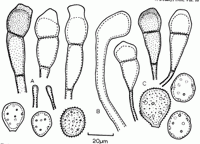|
 Puccinia polypogonobia Puccinia polypogonobia
BiostatusPresent in region - Indigenous. Endemic
Images (click to enlarge)
Caption: Fig 1 a, Puccinia rara McKenzie, teliospores, urediniospores, and paraphyses. b, P.
crinitae McNabb, paraphysis. c, P. polypogonobia, teliospores and urediniospores.
Specimens mounted in hydrous lactophenol. |
Article: McKenzie, E.H.C. (1980). New graminicolous rust fungi, Puccinia rara sp. nov. and P. polypogonobia sp. nov. New Zealand Journal of Botany 18(3): 335-337 (http://www.rsnz.org/publish/abstracts.php).
Description: Aecia not known. Uredinia µmphigenous, golden brown. Urediniospores (21-) 23-30 (-32)
x (11.1-) 19-22 (-23) µm, globose or obovoid, wall (1.5-) 2-2.5 (-3) µm thick, yellow,
finely echinulate, germ pores (7-) 8-10, scattered, with conspicuous caps. Telia
µmphigenous and on culms, blackish brown. Teliospores (34-) 39-52 (-60) x (14-) 16-20 (-24) µm,
constricted at septum, wall 1-1.5 µm thick at sides, (2-) 3-5 (-6) µm at apex,
smooth, golden brown apically, paler basally, upper cell ellipsoidal or obovoid, lower cell
obovoid; pedicles collapsing and broken to c. 30 x 5-8 µm, hyaline.
Notes: This rust differs from Puccinia polypogonis Speg. as described and figured by Cummins
(1971), and confirmed by examination of the isotype (PUR), principally by the narrower
urediniospores of P. polypogonobia (av. 19-22 µm versus 22-26 µm), and greater number
of germ pores ((7-) 8-10 versus 5-7 (-8)) in the urediniospores. The teliospores of P.
polypogonobia are narrower than those of P. polypogonis (av. 16-20 µm versus 20-24
µm), and the septum is in the upper half of the teliospore, whereas in P. polypogonis
the septum is nearly median. P. polypogonis has been recorded on Polypogon chilensis
(Kunth) Pilger, P. interruptus H. B. K., and P. monspeliensis from South America and
South Africa.
|